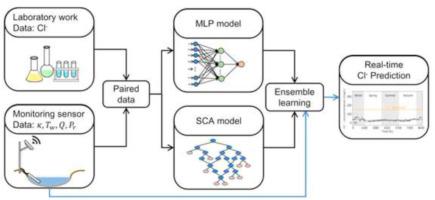Environmental Pollution ( IF 7.6 ) Pub Date : 2021-09-07 , DOI: 10.1016/j.envpol.2021.118116 Qianqian Zhang 1 , Zhong Li 2 , Lu Zhu 3 , Fei Zhang 4 , Emil Sekerinski 5 , Jing-Cheng Han 6 , Yang Zhou 6

|
Real-time river chloride prediction has received a lot of attention for its importance in chloride control and management. In this study, an artificial neural network model (i.e., multi-layer perceptron, MLP) and a statistical inference model (i.e., stepwise-cluster analysis, SCA) are developed for predicting chloride concentration in stream water. Then, an ensemble learning model based on MLP and SCA is proposed to further improve the modeling accuracy. A case study of hourly river chloride prediction in the Grand River, Canada is presented to demonstrate the model applicability. The results show that the proposed ensemble learning model, MLP-SCA, provides the best overall performance compared with its two ensemble members in terms of RMSE, MAPE, NSE, and R2 with values of 11.58 mg/L, 27.55%, 0.90, and 0.90, respectively. Moreover, MLP-SCA is more competent for predicting extremely high chloride concentration. The prediction of observed concentrations above 150 mg/L has RMSE and MAPE values of 9.88 mg/L and 4.40%, respectively. The outstanding performance of the proposed MLP-SCA, particularly in extreme value prediction, indicates that it can provide reliable chloride prediction using commonly available data (i.e., conductivity, water temperature, river flow rate, and rainfall). The high-frequency prediction of chloride concentration in the Grand River can supplement the existing water quality monitoring programs, and further support the real-time control and management of chloride in the watershed. MLP-SCA is the first ensemble learning model for river chloride prediction and can be extended to other river systems for water quality prediction.
中文翻译:

使用集成学习实时预测河氯浓度
实时河流氯化物预测因其在氯化物控制和管理中的重要性而受到广泛关注。在这项研究中,开发了人工神经网络模型(即多层感知器,MLP)和统计推断模型(即逐步聚类分析,SCA)来预测河流水中的氯化物浓度。然后,提出了一种基于 MLP 和 SCA 的集成学习模型,以进一步提高建模精度。提供了加拿大格兰德河每小时河流氯化物预测的案例研究,以证明模型的适用性。结果表明,所提出的集成学习模型 MLP-SCA 在 RMSE、MAPE、NSE 和 R 2方面与其两个集成成员相比提供了最佳的整体性能值分别为 11.58 mg/L、27.55%、0.90 和 0.90。此外,MLP-SCA 更能预测极高的氯化物浓度。对高于 150 mg/L 的观察浓度的预测分别具有 9.88 mg/L 和 4.40% 的 RMSE 和 MAPE 值。所提出的 MLP-SCA 的出色性能,特别是在极值预测方面,表明它可以使用常用数据(即电导率、水温、河流流速和降雨量)提供可靠的氯化物预测。大河氯离子浓度的高频预测可以补充现有的水质监测方案,进一步支持流域氯离子的实时控制和管理。











































 京公网安备 11010802027423号
京公网安备 11010802027423号